

|
<<< Continued from previous page BookThink: I've heard that GWV purchased many books unbound so as to have them bound to his preference. Durham: Yes, he bought many books from publishers and had his own binding preferences done using prominent binders of the day, notably Riviere & Sons of London.
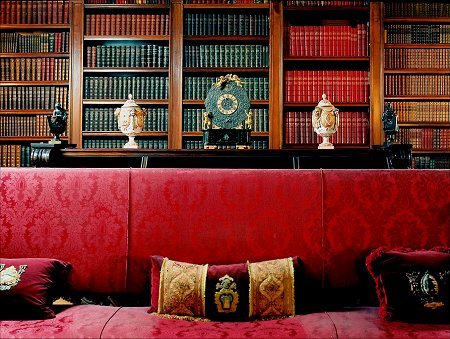
BookThink: Here is an excerpt from the Sandusky Daily Register, October 22, 1890, that seems to conflict with the present-day reality of the library: "He is not a bibliophile, as Brayton Ives, late president of the Stock Exchange, and some other wealthy men are, but he buys a book for what is in it, rather than on account of its age, exquisite binding or any other peculiarity which makes books sought for by bibliophiles. When there are new publications which the publisher with whom he deals thinks he would like they are sent to him for inspection, and he is one of the rich men in New York to whom the dealer in old books sends a private and special catalogue when something choice has been received and is for sale." Do you have some sense of the criteria Vanderbilt used for purchasing books? Was it primarily motivated by his interests? Durham: We don't have any direct evidence explaining how George Vanderbilt made his book-buying decisions. Certainly he was influenced by what was considered popular for the day. We have correspondence showing that Vanderbilt was personally fond of Sir Walter Scott all his life. Obviously, he had sufficient wealth to also be solicited by book dealers who came across rare and valuable titles at estate sales in Europe. BookThink: So there's no indication that he purchased books on the basis, say, of building a more general collection that would address the needs/wants of visitors, etc.? Durham: He has more than 100 works by Balzac, for example, but we don't know if that was for the content or whether it was considered a well-equipped library to have Balzac so heavily represented. BookThink: Is access to the library ever granted for purposes of academic research? Durham: For original academic research, we have a policy of allowing access to parts of the collection. However, here we must be truthful and say that very little of Vanderbilt's collection is truly rare. Most books in his collection can be found at libraries and other repositories around the country, which are equipped to handle researchers. BookThink: Then would it be fair to say that the value of the collection lies primarily in its provenance and the overall quality of bindings? Durham: There are a few extremely valuable and rare items in the collection, though primarily it's the provenance. Not sure I would say the bindings give it its greatest value, though certainly a significant feature. BookThink: Approximately how long has it been since open access (to guests, etc.) was available? Durham: I imagine that once the house was no longer used as a residence (1954), the library was no longer used by guests or visitors. The house was opened to paid tours in 1930, but we have no evidence that these visitors were allowed to peruse the Library collection.
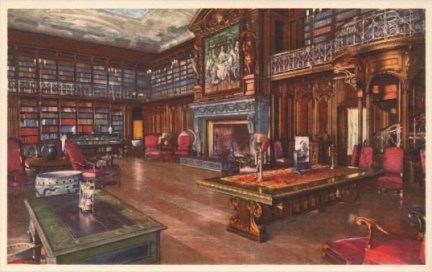
BookThink: Is the present day appearance of the library (and arrangement of books on shelves) more or less as it was 100 years ago? Durham: We don't know if the current appearance of the Library books resembles its original design. BookThink: How are the books organized on the shelves? Durham: Roughly speaking, the shelves to the left of the fireplace (balcony) cover U.S. history and to the right literature. The balcony level east wall also holds literature books, and the west balcony wall seems to cover world history. On the main floor, east wall, are reference works especially dealing with architecture and art. The west wall contains bound periodicals and reference works on architectural and art antiquities. The south wall contains travel, English grammar reference and art/architecture titles. BookThink: If and when items are moved, is this at the discretion of the curator or is the family sometimes consulted? Durham: Over time, books have been removed and replaced by curatorial staff based on the physical condition of the book. In the past year, we replaced a substantial number of balcony level damaged books with books from storage whose bindings were in good condition. BookThink: Vintage landscape architecture titles are a profitable niche for booksellers now. Can you tell something about this portion of the collection? Approximately how many titles? Anything else? Durham: We can't approximate the number of landscape design books, partly because we have not finished the inventory and partly because we have not done subject heading cataloguing as previously discussed. Keyword searches can be done on titles and authors; again, if you are interested in a particular author or title, we'll be happy to check. BookThink: Did Vanderbilt take an active part in the landscape design of Biltmore and, in turn, acquire these books for that purpose? Durham: Frederick Law Olmsted was Vanderbilt's chief advisor and designer in landscaping the Biltmore Estate. We do not have evidence that Vanderbilt contributed to the landscape design, though he was certainly consulted and had veto power. In fact, Olmsted's early plan called for a vegetable garden in part of the gardens area and this was not pursued in favor of ornamental flowers, shrubs and trees. BookThink: I noticed a free-standing shelving unit on the far side of the library with angled compartments for books. What was the purpose of this?
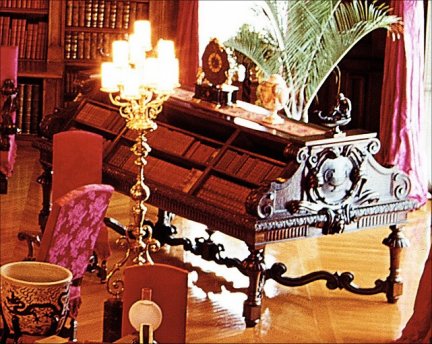
Durham: The book stand you refer to along with three sets of carved steps were designed by Richard Morris Hunt in the Italian Baroque style for the Library. It has compartments for displaying books flat at an angle, and we can guess that this arrangement would have allowed display of very old books whose bindings were not designed for the upright, spine-out display we know today. Early books were shelved lying flat. Just a guess.
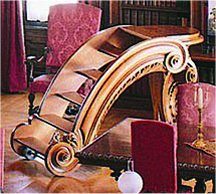
BookThink: Can you tell me anything about the large globe to the left of the fireplace? Durham: The globe dates from 1899 and is mentioned in your guidebook.
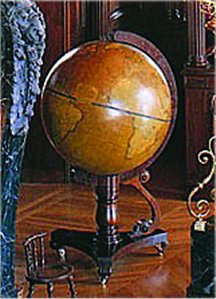
[EDITOR'S NOTE: I want to buy it.] BookThink: The Den off the library has been the subject of at least some speculation over the years - specifically, what it was used for. On a copy (perhaps not authentic) of Hunt's original plans I noted that it was marked "chapel," but it has also been characterized as a scriptorium or chamber of silence. Was it simply a reading room? Durham: The Library Den was said to have been used by Vanderbilt as an office. It certainly commands the best view of the Estate along with the view from his bedroom. It is said it was here that he met with employees to address their concerns. We have no records in our collection referring to this space as a chapel. Though it has been filled with a much later era of book shelving, and contained several thousand books until recently, we do not have evidence this room was used as a library. BookThink: Why is it closed to the public? Durham: It was open for tour at one time from the loggia, but due to weather and flow problems, was closed again. BookThink: A final question - there are some subtly hinged panels on the library walls, one of which, I'm told, now conceals an electrical panel. Any idea what these were originally used for? Durham: The one next to the fireplace conceals an electrical panel, which was original with the construction of the house. We don't know the purpose of the other panels, though in contemporary times, they have been used to store light bulbs, window props, etc. BookThink: Thank you, Suzanne, for sharing your expertise with us. EDITOR'S NOTE: Suzanne K. Durham has been Special Collections Manager for The Biltmore Company since 2003. She has worked in university libraries and public archives In Virginia and Kentucky since 1989. She received her MLS from the University of Kentucky. For "A Brief Bibliography of Gardening and Related Books in the GWV Library," click here.
< to previous article
to next article >
Questions or comments?
| Forum
| Store
| Publications
| BookLinks
| BookSearch
| BookTopics
| Archives
| Advertise
| AboutUs
| ContactUs
| Search Site
| Site Map
| Google Site Map
Store - Specials
| BookHunt
| BookShelf
| Gold Edition & BookThink's Quarterly Market Report
| DomainsForSale
| BookThinker newsletter - free
Copyright 2003-2011 by BookThink LLC
|

|
|